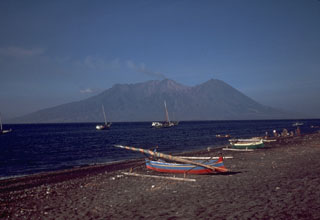Report on Sangeang Api (Indonesia) — November 1985
Scientific Event Alert Network Bulletin, vol. 10, no. 11 (November 1985)
Managing Editor: Lindsay McClelland.
Sangeang Api (Indonesia) Strombolian explosions; lava flow in growing channel; pyroclastic flow deposit
Please cite this report as:
Global Volcanism Program, 1985. Report on Sangeang Api (Indonesia) (McClelland, L., ed.). Scientific Event Alert Network Bulletin, 10:11. Smithsonian Institution. https://doi.org/10.5479/si.GVP.SEAN198511-264050
Sangeang Api
Indonesia
8.2°S, 119.07°E; summit elev. 1912 m
All times are local (unless otherwise noted)
"Sangeang Api continued to erupt with 10-30 Strombolian explosions/day in November and the first week in December. The 1985 lava channel had not lengthened from the 4.7 km observed in late September. However, the volume of the main channel has grown because of a considerable increase in height during the past 2 months. A slow-moving lava flow in the central channel is located atop the main feeder tube. Periodic overflows of this channel add both fluid lava and rubble to the outer flanks of this tube. On 5 December, four separate overflows of fluid lava and rock rubble were observed rolling down the sides of the central channel.
"A brief visit was made to the central crater on 4 December during a period of quiet. The active vent was a large cinder cone in Doro Api Crater. This central cone, which previously rose about 40 m from the floor of Doro Api, was estimated to be approximately 180-200 m above the floor during the 4 December visit. Thundering detonations were heard almost continuously during the 15 minutes spent in the crater and 1 mild Strombolian explosion hurled incandescent blocks. At night, a continuous reddish glow at the bottom of the gas plume over the crater suggested that a small lava lake may exist within Doro Api or the central cone. Fountaining of fluid lava, sheets, or ribbons was observed to accompany some of the larger Strombolian explosions at night.
"We also confirmed the existence of a small-volume pyroclastic flow that was probably produced during the initial activity of 30 July. Local residents reported that the activity caused a number of small fires in the vicinity of Doro Montoy crater (just N of Doro Api) and the Sori Mbere drainage on the S flank of the volcano. A small block and ash flow, still hot to the touch, was found in the Sori Mbere drainage in December. Lahars generated by heavy rainfall and unconsolidated material on the upper slopes of the volcano have been common during and immediately after previous episodes. Outcrops along the shoreline indicate that a number of lahars and possibly also pyroclastic flows have entered the sea. Small mudflows were produced by heavy rains on 2 December. One traveled down the Sori Mbere drainage while a second mudflow entered the sea at Oi Nono Jara on the S side of Sangeang Island.
"This pattern of activity conforms to that of previous 20th century eruptions of Sangeang Api. The 1911 activity included numerous explosions and a lava flow from the summit crater that moved more than 6 km down the W flank. The activity that began in March 1953 produced a lava flow and intermittent explosions through 1954. The 1964 eruption began on 29 January with strong explosions from the 1954 crater, and a lava flow first observed on 3-4 February moved N and E to about 750 m elevation. Explosions and outflow of lava continued for at least several months and possibly until the end of 1965."
Geological Summary. Sangeang Api volcano, one of the most active in the Lesser Sunda Islands, forms a small 13-km-wide island off the NE coast of Sumbawa Island. Two large trachybasaltic-to-tranchyandesitic volcanic cones, Doro Api and Doro Mantoi, were constructed in the center and on the eastern rim, respectively, of an older, largely obscured caldera. Flank vents occur on the south side of Doro Mantoi and near the northern coast. Intermittent eruptions have been recorded since 1512, most of them during in the 20th century.
Information Contacts: T. Casadevall and L. Pardyanto, VSI.

